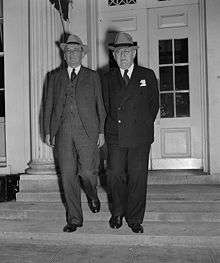Brownlow Committee
The President's Committee on Administrative Management, commonly known as the Brownlow Committee or Brownlow Commission, was a committee that in 1937 recommended sweeping changes to the executive branch of the United States government. The recommendations made by the committee resulted in the creation of the Executive Office of the President. It had three members; they were Louis Brownlow, Charles Merriam, and Luther Gulick. The staff work was managed by James P. Harris, Director of Research for the committee.

Some of the most important recommendations from the council include creating aides to the President in order to deal with the administrative tasks assigned to the President. It also suggested that the President should have direct control over the administrative departments. In its third suggestion, the committee said that the managerial agencies – The Civil Service Administration, the Bureau of the Budget, and the National Resources Board – should be part of the Executive Office.[1]
The Reorganization Act of 1939 incorporated only two of the recommendations in the 53-page report delivered by the committee. However, the Act provided to President Franklin D. Roosevelt the authority to make changes so that most of the various agencies and government corporations were organized within various cabinet-level departments, greatly improving accountability among the various agencies.
The most important results of the actions taken by Roosevelt were the creation of the Executive Office of the President and the creation of a group of six executive level assistants. The Brownlow Committee warned that the agencies had grown increasingly powerful and independent, and proposed reforms designed to tighten the president's control over these agencies. The committee proposed a plan to consolidate over 100 agencies into 12 departments and allowed the president to appoint several assistants.
Most Americans opposed giving the president any more power, as a Gallup poll found in April 1938.[2] Nevertheless, after winning the approval of Congress, Roosevelt signed the Reorganization Act of 1939. Roosevelt then established the Executive Office of the President, which increased the president's control over the executive branch. Roosevelt combined several government public works and welfare agencies into the Federal Works Agency and the Federal Security Agency. He also transferred the powerful Bureau of the Budget from the Treasury Department to the Executive Office of the President.[3] The new law also made possible in 1940, the Office of Emergency Management, which enabled the immediate creation of numerous wartime agencies. The reorganization is best known for allowing the President to appoint numerous assistants and advisers. Those who built a network of support in Congress became virtually independent "czars" in their specialized domains. [4]
Other similar commissions
- Hoover Commission two commissions in 1947–1949 and 1953–1955.
- The Grace Commission 1982–1984
- National Partnership for Reinventing Government 1993–1998
- Project on National Security Reform 2006–present
Precursor commissions and committees
See also
References
- Barry Dean Karl, Executive Reorganization and Reform in the New Deal (1963)
- Dickerson, John (May 2018). "The Hardest Job in the World". The Atlantic. Retrieved 25 April 2018.
- George McJimsey, The Presidency of Franklin Delano Roosevelt (2000) pp. 171–84.
- Harold C. Relyea, "The Coming of Presidential Czars and their Accountability to Congress: The Initial Years: 1937–1945." White House Studies 11#1 (2011), pp. 1–20.
Further reading
- Fesler, James W. (Aug 1987), "The Brownlow Committee Fifty Years Later", Public Administration Review, Public Administration Review, 47 (4): 291–296, doi:10.2307/975308, JSTOR 975308
- Karl, Barry Dean. Executive Reorganization and Reform in the New Deal (1963)
